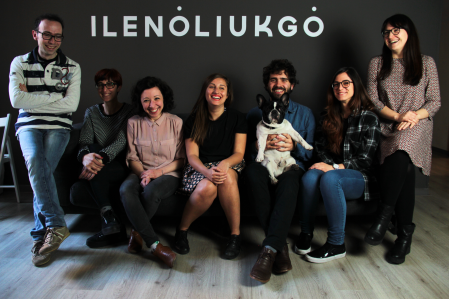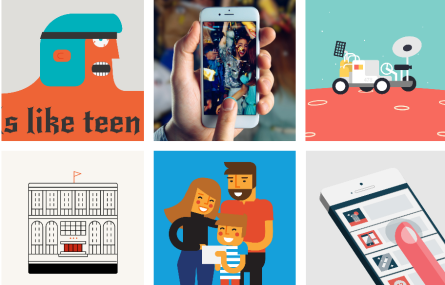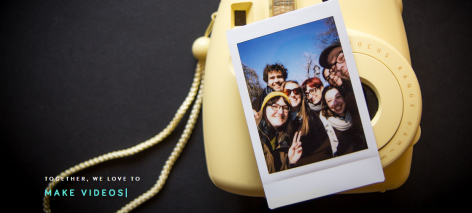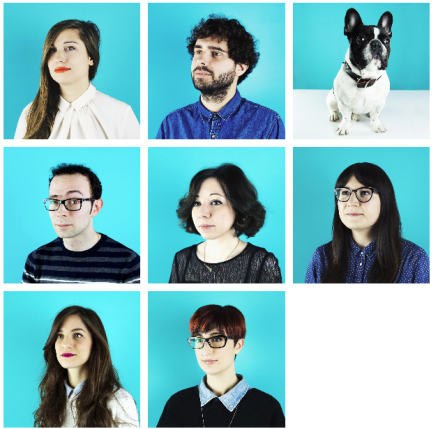Motion graphics are a way to do commercial advertising that is spreading more and more nowadays. We like to think of motion graphics as a new kind of digital art with its own world, rules and artists. In the last ten years this little world has grown up also thanks to more powerful hardwares and new softwares or plugins and it is revolutionizing the commercial advertising. So we decided to examine in depth the motion graphics enviroment interviewing a studio that is just turned into a company, but that began its path as a start-up making motion graphics videos. Its name is Illo (http://illo.tv/).
Introduction
Who is ILLO?
Luca: ILLO is a creative studio which produces innovative things.
Formation
Tell us about yourselves: when was your own start-up born? What kind of work do you do? How is your team composed?
Ilenia: Illo was born as Ilenoliukgo in 2011. It started as a small company of newly graduated duo, me and Luca, but we started to expand and it became a company for real (S.r.l.) in august 2012. We mainly create video, but we also produce illustration, infographics, interface design, user experience. Our team is very varied, each one of us has a multidisciplinar knowledge. Who draws is able to manage the sound design, who animates is able to do the copywriting. It’s something we inherited from our master degree – Cinema and Media Engineering.
Luca: Practically speaking, we are 3 animators and 3 illustrators.
Ilenia: The last person is a studio problem solver, which work is trasversal to all the team and help us in many fields.
What’s your education?
Ilenia: Our path are quiet heterogeneous. My high school studies had a classic orientation, then I chose Production Engineering at the Politecnico di Torino as bachelor’s degree, and I had the possibility to study one year in Torino and one year in Paris. This degree has an engineer-like approach, very different from the one I got from my master degree – Cinema and Media Engineering.
Luca: I studied in a scientific oriented high school, then I started a bachelor’s degree in Communication Science, which was very theoretical and less practical than Cinema and Media Engineering degree, but it’s where I fell in love with advertising. I’ve concluded my studies with the same master degree as Ilenia.
Not too long ago, three of you were students in the same university course that we’re attending now and we wish to take advantage of your experience; what did Cinema and Media engineering teach you from the point of view of education on the one hand and in the light of the difficulties that you noticed once you began your working life on the other hand? (for instance, relationship with clients, need for teamwork, deadlines or technical aspect of your job)
Ilenia: I’m sure that the degree in Cinema and Media engineering was useful to practically try to do thing and to understand that some projects can be realized for real. At the beginning our work as a small studio wasn’t so much different from what we used to do in our master degree, for example when we had to produce small animated video. Then we started to structure our work…
Luca: Things get more complex, but the practical experience we got from Cinema and Media Engineering is essential to get an effective approach. We learned how to manage diffucult elements such as team work, group dynamics, having someone who takes decisions, someone who works less, …
Ilenia: At Cinema and Media Engineering and in other degree courses too, there is always the challenge of the team work. At the beginning it’s like “wow, we’re going to do a team work all together”, and then you want to beat up anybody else. This is something that doesn’t happen when you begin to work, because you work to be paid from the client and the relationship with him is more formal. Furthermore, all the hierarchies inside the group are formal, you’re not a disorganized student anymore. Still, the university experience is surely valuable.
Luca: Cinema and Media Engineering didn’t teach us much about motion graphics, didn’t teach us everything that we needed. As a student, you can’t expect to get all the informations you need to enter the business world, but you can obtain input to enrich yourself, to learn new things and choose in what you want to be specialized.
Ilenia: I think that the main idea is that Engineering – any kind of, and I speak as someone who has experienced different areas, teaches you that something, anything, can be done; if you get involved, you can do it.
Which is the difference between the relationship with the clients and the relationship with the professors?
Ilenia: From the student’s point of view it’s easier: the teacher has to evaluate a work presented at the end of the course. It’s very different from the feedback you get from a client and that you have to handle, which is something that can only be learned on the field.
Luca: What teached me how to face the clients was the working experience during some stages and the way my bosses and colleagues used to communicate with the client. The working experience helps you build relationships with the people who see your work, use it, and buy it. Also, if an artist is amazing but he can’t present his work to a client, he will only obtain a client unsatisfied with his work, because he will be unable to sell it in the right way. On the other hand, if someone is less creative, or simply worse, but knows the art of selling to the client his idea, can obtain more.
Ilenia: In general, you need diplomacy. Ofter the client expects that the artist wants to do as he likes, but we try to keep a friendly and human relationship.
Luca: We usually keep it informal and it’s something that our clients like.
What’s the thing that struck you about the motion graphics more than other fields so that you decided to found a real start-up?
Luca: At the beginning we didn’t plan to enter the motion graphics world. We started by chance with some advertising products, working with people we knew from our years of master degree. We realized that we had this ability of simplifying the way things were said, using a language that was easy and we were able to synchronize efficiently voiceover and pictures. As students we used to participate to competitions and the most important one – the one that drove us one step ahead towards the motion graphics – has been th Young Lion (http://www.canneslions.com/cannes_lions/awards/young_lions_competitions/). At that competition we had to imagine a new way to communicate for any company, a way that wasn’t even possible to imagine 5 years before – using modern and technological elements. This is something very important for us: now we usually advertise technological products, so that competition was the cornerstone of what we would have been. Producing that video we realized we had all the features that were needed for the production of motion graphics video. After other people had seen that video, the first start-up asked us if we were able to create other videos like that. We actually created a video for that start-up, which was in a competition with other start-ups, and of 15 finalists of that competition we realized a video for 7 of them. The world of mouth gave us the possibility to spread, and that was the moment in which we became aware of the fact that we were doing motion graphics to explain the work of start-ups.
Ilenia: When we started to work with motion graphics that world was more immature, the first videos on internet started to appear, it was the time of the first user generated contents. What lacked at that time and that now is evolving was the design inside the videos. What distinguished our work from the others’ was introducing design, clearness and coherence that already existed in the websites or in other advertising contents, but that was missing in the videos of small budgets, and was specific of high quality televisions.
Style
We’re always extremely impressed by the style and the creativity that your works convey. What is your source of inspiration? Why have you chosen a flat design for your works? In a global context where everybody is gradually following this kind of style, isn’t it even more difficult to differ from the other competitors?
Ilenia: We chose the flat design because it was one of the major trends of these years and because it is closely connected to the motion graphics, specifically for videos designed to advertise start-ups. Also, the creative process of production of 3D videos is much more complex.
Luca: If you design the elements in a simpler and geometric way, it will be easier to animate them. That’s why now is very common to use flat design.
Ilenia: It’s the same process that involved websites: at the beginning they were full of textures and 3D effects, and now they’ve become simpler. If we think of going back to that style it would seem strange, and that’s why we think that the motions graphics will evolve on that path. We also notice that the trends change every year, but it will always be characterized by simplicity of shapes. Maybe will be introduced different kind of videos, such a 3D and live action, but the motion graphic will follow that trend.
Ilenia: What distinguish us from others is not just the flat style, which is only one of the components inside our motion graphics videos, but also the mix of the elements. It is very important for us to have clear scripts, with just a hint of irony and a well-finished design.
Luca: The problem with flat style is that more and more people today use it in the wrong way; for instance, in web pages you can often find photos associated to flat icons and the result is quite embarassing, but this is normal, each trend leads to its own declines. We always try to be careful about the ways in which this style may evolve in the future and it is a challenge for us to sense its changes before our competitors or at the same time, at least.
Ilenia: In addition to the product, a great uniqueness is also given by the team that stands behind it: the 50% of our job is create a good product, the other 50% is be able to talk with the client and manage to live as a team.
Technical and creative/artistic capacities coexist in your works and, more in general, in this discipline. How did you get that balance which makes your videos so beautiful?
Ilenia: The two things are closely connected bacause if you have good ideas but you can’t realize them, they stay only in your mind without becoming concrete. The technical education we have received has been relevant in matter of the team’s choices and management. We don’t believe in creatives who don’t draw or animate.
Luca: We think that the traditional approach of the ‘50s agencies, which involved a copywriter and art director, is not the appropriate one for today’s demand; maybe the perfect motion designer is the one who can do both things, working on the design and later animating it, in order to have both elements fluid, well linked and completely integrated with each other.
Ilenia: In addition, a central element is the ability of telling a story, therefore it is good to dedicate some time to the copywriting and scripting.
Luca: Artistic and technical skills are different, but we have to go through them together, then each one specializes in something. The aesthetic taste grows slowly, by looking around and choosing what you really like; we spend a lot of hours on Dribbble (https://dribbble.com/) to watch other designers’ works and spots in order to improve our taste about communication strategies. We don’t like to create contents which are enjoyed by captive audience as in traditional spots, but we prefer the user to choose whether click the play button to get some information more quickly than the ones you can read from a web page.
How do you deal with your style and the need for brand awareness of the companies?
Luca: They come together. Our company has its own style, but it is necessary because the business world refers to it in order to contact us. We try to be open to approach different styles and understand that there are different kind of requests from the client, but at the same time it’s advantageous that the clients know what you’re able to do and that you do it very well.
Ilenia: We worked with Ferrero and Poste Italiane; with such big clients, there are a lot of constraints, for example about colors, fonts and character design. We have to consider if the product is addressed to a local market or to an international one, or for a b2c or b2b market. Even if we adopt our style we change it according to the client social channel so that it is well integrated with everything else.
Luca: If the client is a start-up and it has not a lot of budget, time and resources to think about what it really wants, we like to think that our business may represents a tiny step towards the creation of the client’s brand identity.
Ilenia: Each video is unique, we never reuse elements. We always design them from scratch and even if this seems to be a waste of time we believe that this makes the difference.
Luca: In short we have to create the prototype each time we work for a client; we always start from a black sheet.
Broadly speaking, could you describe the steps which lead to the creation of your products? Which kind of softwares do you usually work with?
Ilenia: We start with a brief with the client who tells us his needs and the goal of the video, we understand the target and the basic idea, we clarify practical aspects such as licences. This step is very important because, as we said previously, we’re working on very innovative projects, so it’s a bit difficult to illustrate them.
Luca: There are two more steps: the first one is the designing, the second one is the production. The designing lasts about two or three weeks; we submit a script in Italian or in English. If the client needs the video in many languages, we start to work with one and then we translate. We work on the script along with the client, we propose an idea and the client tells us what he thinks about it, or what should be changed. Then there is the storyboard phase where we sketch an image for each script phrase. After that begins the art direction phase where we create two or three style-frame in order to give a visual idea about the final video. Then we look for a voiceover, we call some dubber we know and we organize an audition to choose the best dubber for the project.
Ilenia: We move on the production step. Since we’re speaking about motion graphics video, we illustrate every scene based on our result from the storyboard and the art direction phases and we record the voiceover. In the end, we begin to animate and we exploit the voiceover to get a good timing for our animations. It is necessary that the animation is consistent with the voice in order to illustrate the idea, especially when we’re working on concept videos.
Luca: When you do this kind of work you can choose to have audio and video in synchronization or not: in the first case you can strengthen the idea, in the second one you can create an ironic picture, for example.
Ilenia: Since we’re speaking about audio, the sound design is the last phase. We create our own sounds for our works, especially when the animation has meaning only if there is a precise sound.
Do you have someone who composes music for you?
Luca: It depends, sometimes we buy musics online with commercial licence, otherwise we work with composers who create our own music, or we use Meo (a member of our crew) and his passion for music. Sometimes it’s hard to pick the right music for the video because it’s one of the last things we usually do. In some cases we decide to move up this step, especially if we’re working on an emotional video (which needs a strong effort in the choice of music) and the voiceover is missing.
Ilenia: Obviously, it’s also difficult to pick the right music if you don’t compose it by yourself, because you have to adapt it to your work based on length of your video.
What is some advice you’d like to share with a newly graduated who would like to try this field of communication, nowadays? What are the skills that a good motion grapher needs?
Ilenia: My piece of advice is to begin to work even if you’re still a student and to get some experience during a stage in a company, because it really helps to find a job in the future. For instance, when we had to hire people, we took into account if someone did any kind of job. Generally speaking, it’s essential to be accostumed to work, even if the working experience someone had was different from what we required. Specifically, it’s important to try both to paint and to animate, even if at the beginning someone might be better in one role than in the other one. If someone wants to be a freelancer, he should probably be good at both.
Luca: Another piece of advice is to do experience in a foreign country, working or studying; we live in a global market, we work on Internet, so it’s important to speak English and relate to other foreign entities. English is essential, especially in the little world of motion graphics. For us it’s normal to work for foreign clients and, since we tell stories through our videos, it’s very important that we’re able to speak English and other languages. In our case, it was fundamental to speak English because when we started to work as a studio, although our clients were Italians, we had to help them to internationalize their companies. So at the beginning, more or less the half of our videos was in English; now, since the 60%-70% of our clients are abroad, we use English in about 85% of our videos. We should be able to speak English also for understanding the feedbacks in the right way. We also have to convince our foreign clients to trust us and this isn’t always easy, but we don’t have to be afraid to speak other languages.
Ilenia: In the end, we have some advice about the university. We suggest getting a master degree because it allows you to get experience of doing some teamwork and it helps you to understand what you want to do in your professional life. Don’t think that having a master degree represents immediatly an advantage, maybe it takes four or five years before it makes the difference. If you got a master degree, you could be considered more easily by the employers not only because it represents a title, but also beacuse it shows that you spent more years studing than others and this means that you’re able to learn new things easily and that you’re good at relating to other people.
Luca: I suggest spending the first years of university doing personal projects, creating your own portfolio, looking around and searching interesting people you want to work with. For instance, you could watch videos that you like and try to do it by your own, frame by frame: “fake it until you make it”. When I chose which kind of university course attend, I didn’t think that in the near future I would manage a team of about three or four animators, instead of animating myself. In my opinion, that was where the master degree becomes useful: managing other people.
Ilenia: My last advice is to not underestimate the degree thesis because it represents a moment where you can work on your own project and you don’t have to work for a client yet.
Luca: It is also true that you can do it wrong, as we did. Our degree thesis was about stereoscopic 3D, a topic that was mainstream at that time. We started to work thinking something like: “Well, we’re going to do a lot of streoscopic videos, that’s what we do!”. Never done it, actually we’re extra-flat. But you have to choose what you like when you have to begin your degree thesis and even if you will change your mind about what you want to do in the future, it still represents a good opportunity to do what you like for some month.
Ilenia: But don’t take more than six months.
Do you have some idea about what might be the future of motion graphics since always more companies are working in this field?
Luca: The motion graphics are getting more and more widespread. It’s like what happened in the case of the websites: about ten years ago, few people knew how to develop them, but now people that are able to do this kind of job have increased. As for websites, there are two kinds of target: the ones that want a working and nice website (which template can be easily bought online) and the ones who want customized contents. We have decided to work for clients who are looking for a complete customization and high-level products. We’re growing slowly but constantly and we try to increase the quality of our work. Our eternal problem is: on one hand we have to guarantee a great quality, on the other hand we want to hire young people who might be inexperienced.
Ilenia: As for the trends, the first one was the kinetic typography, i.e animate writings; nowadays few people still request this kind of videos. Then people began to look for animate infographics and today the trend is the storytelling, so there are a lot of videos with characters and abstract situations. The human element is often present.
Luca: Another trend is to use a voiceover in motion graphic videos or the use 3D elements (that appears flat thanks to the use of the color) in a 2D video, so exploiting softwares like Cinema4D for authentic 3D or After Effects for fake 3D.
Ilenia: The motion graphics world is getting richer by using little magical touches, but keeping simple shapes: that’s what we try to do. For instance, the cell animation is one of these and today more and more clients request it even if only for some details.
There are companies very famous among your clients, how did you get them?
Luca: We got them thanks to our references and that came unexpected. Since our clients are moslty gathered in an online business community, our name spread through with the word of mouth. If someone is pleased with the job that you do, it’s easy that he/she tells other people about you and so you can get bigger clients. At first, some agency contacted us to give us works for the biggest clients. At the same time we began to participate in public tenders.
Ilenia: Contacts are important. For example, we often have worked with some ex university mates who knew what we’re able to do and that we’re good at making motion graphics video, so they contacted us.
Luca: We gradually grow our connection and even if we don’t partecipate in events, it’s not impossible to be contacted at all.
Ilenia: In my opinion, the most incredible thing that happened to us was when UEFA (Union of European Football Associations) contacted us in order to create a video which had to show a new kind of tournament. This was possible thanks to a guy who worked for the UEFA animation team and who follows us on Vimeo. He told the communication department about us and we were contacted by it.
Ilenia: And then we all were singing the Champions League theme.
Illo team: Ilenia Notarangelo, Luca Gonnelli, Matteo Ruffinengo, Carla Gioia, Cristina Pasquale, Miriam Palopoli, Claudia Losini
Chroma Chi? Alessandra Caretto Nicola Falomi Enrica Maggiora Francesca Milani Federico Montemurro








